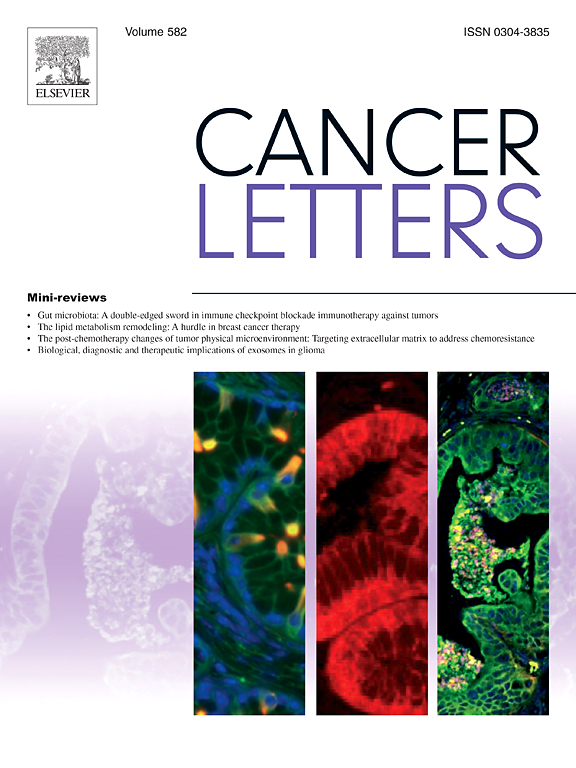人工智能信息的计算病理学分类器预测肌肉侵袭性尿路上皮癌治疗方式的结果。
IF 10.1
1区 医学
Q1 ONCOLOGY
引用次数: 0
摘要
尿路上皮癌(UC)是癌症相关死亡的主要原因之一,有效的、可扩展的治疗计划生物标志物仍然有限。我们提出了UC-TIL,这是一种基于人工智能(AI)的模型,可以量化常规h&e染色玻片中肿瘤浸润淋巴细胞(til)的空间模式,以预测生存和免疫治疗反应。我们分析了三个队列的558张全片图像:TCGA (D0&1, N=292), Emory (D2, N=161)和TRRC2819 (D3, N=105),涵盖化疗和免疫检查点抑制剂(ICI)治疗。UC-TIL分级与局部晚期疾病(D1和D2)的OS (HR=2.11, 95%CI:1.01-4.41, p=0.011)和PFS (HR=3.68, 95%CI:1.07-12.65, p=0.0012)相关,与转移性疾病(D3)的结果一致(HR=1.73, 95%CI:1.08-2.77, p=0.043; PFS HR=1.73, 95%CI:1.07-2.81, p=0.047)。在ci治疗的D3队列中,UC-TIL达到AUC=0.757,识别无应答者的特异性为91%。UC-TIL通过分析标准病理切片的空间TIL模式,可以对局部晚期和转移性尿路上皮癌进行可靠的风险分层和治疗反应预测。这些发现将UC-TIL定位为一种易于部署的工具,用于指导多种临床环境下的个性化治疗。本文章由计算机程序翻译,如有差异,请以英文原文为准。
AI-informed computational pathology classifier predicts outcomes across treatment modalities in muscle-invasive urothelial carcinoma
Urothelial carcinoma (UC) is one of the leading causes of cancer-related mortality, and effective, scalable biomarkers for treatment planning remain limited. We present UC-TIL, an artificial intelligence (AI)-based model that quantifies spatial patterns of tumor-infiltrating lymphocytes (TILs) from routine H&E-stained slides to predict survival and immunotherapy response. We analyzed 558 whole-slide images across three cohorts: TCGA (D0&1, N = 292), Emory (D2, N = 161), and TRRC2819 (D3, N = 105), spanning chemotherapy and immune checkpoint inhibitor (ICI) treatments. UC-TIL classification was associated with OS (HR = 2.11, 95 %CI:1.01–4.41, p = 0.011) and PFS (HR = 3.68, 95 %CI:1.07–12.65, p = 0.0012) in locally advanced disease (D1 and D2), with consistent results in metastatic disease (D3) (HR = 1.73, 95 %CI:1.08–2.77, p = 0.043; PFS HR = 1.73, 95 %CI:1.07–2.81, p = 0.047). In the ICI-treated D3 cohort, UC-TIL achieved AUC = 0.757 and identified non-responders with 91 % specificity. UC-TIL enables reliable risk stratification and treatment response prediction in both locally advanced and metastatic urothelial carcinoma by analyzing spatial TIL patterns from standard pathology slides. These findings position UC-TIL as a readily deployable tool to guide personalized therapy across multiple clinical settings.
求助全文
通过发布文献求助,成功后即可免费获取论文全文。
去求助
来源期刊

Cancer letters
医学-肿瘤学
CiteScore
17.70
自引率
2.10%
发文量
427
审稿时长
15 days
期刊介绍:
Cancer Letters is a reputable international journal that serves as a platform for significant and original contributions in cancer research. The journal welcomes both full-length articles and Mini Reviews in the wide-ranging field of basic and translational oncology. Furthermore, it frequently presents Special Issues that shed light on current and topical areas in cancer research.
Cancer Letters is highly interested in various fundamental aspects that can cater to a diverse readership. These areas include the molecular genetics and cell biology of cancer, radiation biology, molecular pathology, hormones and cancer, viral oncology, metastasis, and chemoprevention. The journal actively focuses on experimental therapeutics, particularly the advancement of targeted therapies for personalized cancer medicine, such as metronomic chemotherapy.
By publishing groundbreaking research and promoting advancements in cancer treatments, Cancer Letters aims to actively contribute to the fight against cancer and the improvement of patient outcomes.
 求助内容:
求助内容: 应助结果提醒方式:
应助结果提醒方式:


